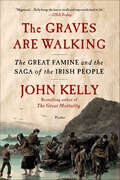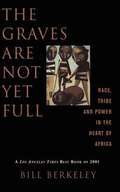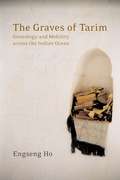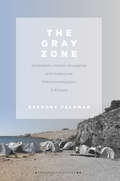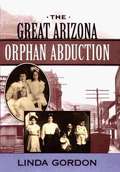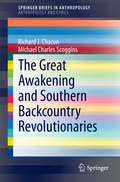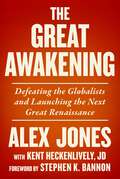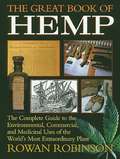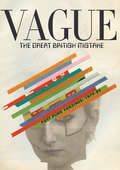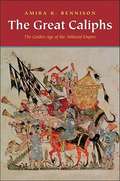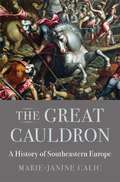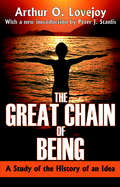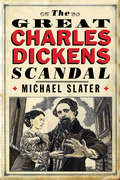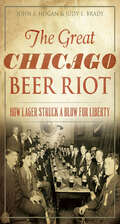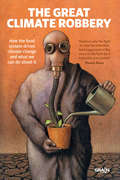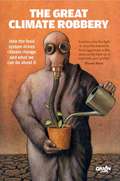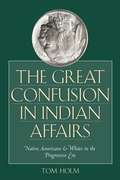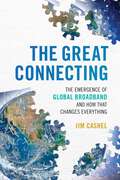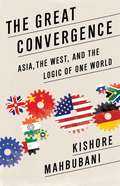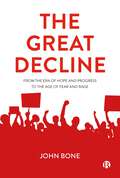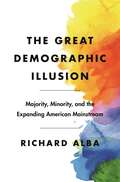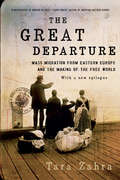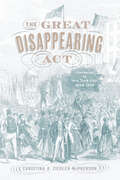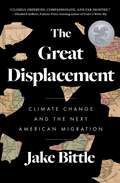- Table View
- List View
The Graves Are Walking: The Great Famine and the Saga of the Irish People
by John Kelly“Though the story of the potato famine has been told before, it’s never been as thoroughly reported or as hauntingly told.” —New York PostIt started in 1845 and before it was over more than one million men, women, and children would die and another two million would flee the country. Measured in terms of mortality, the Great Irish Potato Famine was the worst disaster in the nineteenth century—it claimed twice as many lives as the American Civil War. A perfect storm of bacterial infection, political greed, and religious intolerance sparked this catastrophe. But even more extraordinary than its scope were its political underpinnings, and The Graves Are Walking provides fresh material and analysis on the role that Britain’s nation-building policies played in exacerbating the devastation by attempting to use the famine to reshape Irish society and character. Religious dogma, anti-relief sentiment, and racial and political ideology combined to result in an almost inconceivable disaster of human suffering.This is ultimately a story of triumph over perceived destiny: for fifty million Americans of Irish heritage, the saga of a broken people fleeing crushing starvation and remaking themselves in a new land is an inspiring story of revival.Based on extensive research and written with novelistic flair, The Graves Are Walking draws a portrait that is both intimate and panoramic, that captures the drama of individual lives caught up in an unimaginable tragedy, while imparting a new understanding of the famine’s causes and consequences.“Magisterial . . . Kelly brings the horror vividly and importantly back to life with his meticulous research and muscular writing. The result is terrifying, edifying and empathetic.” —USA Today
The Graves are Not Yet Full
by Bill BerkeleyAccount of the causes behind the Rwandan genocide of 1994.
The Graves of Tarim: Genealogy and Mobility Across the Indian Ocean
by Engseng HoThe Graves of Tarim narrates the movement of an old diaspora across the Indian Ocean over the past five hundred years. Ranging from Arabia to India and Southeast Asia, Engseng Ho explores the transcultural exchanges--in kinship and writing--that enabled Hadrami Yemeni descendants of the Muslim prophet Muhammad to become locals in each of the three regions, yet remain cosmopolitans with vital connections across the ocean.
The Gray Zone: Sovereignty, Human Smuggling, and Undercover Police Investigation in Europe (Anthropology of Policy)
by Gregory FeldmanBased on rare, in-depth fieldwork among an undercover police investigative team working in a southern EU maritime state, Gregory Feldman examines how "taking action" against human smuggling rings requires the team to enter the "gray zone", a space where legal and policy prescriptions do not hold. Feldman asks how this seven-member team makes ethical judgments when they secretly investigate smugglers, traffickers, migrants, lawyers, shopkeepers, and many others. He asks readers to consider that gray zones create opportunities both to degrade subjects of investigations and to take unnecessary risks for them. Moving in either direction largely depends upon bureaucratic conditions and team members' willingness to see situations from a variety of perspectives. Feldman explores their personal experiences and daily work in order to crack open wider issues about sovereignty, action, ethics, and, ultimately, being human. Situated at the intersection of the EU migration apparatus and the global, clandestine networks it identifies as security threats, this book allows Feldman to outline an ethnographically-based theory of sovereign action.
The Great Arizona Orphan Abduction
by Linda GordonThis text tells the disturbing history of racial boundaries along the USA/Mexican border. It focuses on the case of some Irish orphans who were placed with Mexican families, and the resulting anger of the town's Anglos who formed a vigilante squad to kidnap the children away from the Mexicans.
The Great Awakening and Southern Backcountry Revolutionaries
by Richard J. Chacon Michael Charles ScogginsThis work documents the impact that the Great Awakening had on the inhabitants of colonial America's Southern Backcountry. Special emphasis is placed on how this religious revival furrowed the ground on which the seeds of the American Revolution would sprout. The investigation shows how the Great Awakening can be traced to the Europe's Age of Enlightenment. This effort also demonstrates how and why this revival spread so rapidly throughout the colonies. Special focus is placed on how the Great Awakening impacted the mindset of colonists of the Southern Backcountry. Most significantly, this research demonstrates how this 18thcentury revival not only cultivated a sense of American national identity, but how it also fostered a colonial mindset against established authority which, in turn, facilitated the success of the American Revolution. Additionally, this investigation will document (from a cross-cultural perspective) how religious revivals have fueled other revolutionary movements around the world. Such analysis will include the Celtic Druid Revolt, the Maji-Maji Rebellion of East Africa along with the Mad Man's War in Southeast Asia. Lastly, the ethical ramifications of minimizing (or denying) the role that religion played in political and social transformations around the world will be addressed. This final point is of paramount importance given current trend in academia to minimize the role that religion played in spurring revolutions while emphasizing material (i. e. economic) causal factors. This attempt at divorcing religion from history is misguided and unethical because it is not only misleading but it also fails to fully acknowledge the beliefs and values that motivated individuals to take certain actions in the first place.
The Great Awakening: Defeating the Globalists and Launching the Next Great Renaissance
by Kent Heckenlively Alex JonesIn The Great Awakening: Defeating the Globalists and Launching the Next Great Renaissance, the most persecuted man on Earth, Alex Jones, gives you the good news about the failing plans of the globalists to control humanity. The expression &“Get woke, go broke&” has entered the common lexicon as we&’ve seen company after company invoke the false gods of diversity, equity, and inclusion to their financial demise. But this surface discussion masks a much darker truth. What we are witnessing is nothing less than the failed plans of social Darwinists to capture free market capitalism and turn it toward their fascist aims of controlling and depopulating the globe. Working with New York Times bestselling author Kent Heckenlively, Jones masterfully gives you the deeper discussion about such hot button topics as the truth behind the globalists plans for artificial intelligence (AI), the central bank digital currency, social credit scores, Big Tech tyranny, censorship, fifteen-minute cities, the unholy alliance between big business and big government, the military-intelligence-industrial complex—which is hell-bent on eternal war—and the all-out assault on free speech and the Second Amendment. The good news is that these plans are destined to fail, if we wake up to the anti-human future the globalists have planned for us. The globalists hate freedom, and what they hate the most is the greatest freedom document in human history, the United States Constitution. Jones does not shy away from the darker parts of American history—the way we have been systematically deceived by the intelligence agencies since their assassination of President John F. Kennedy—but he provides example after example of people who have broken free from the matrix of lies to tell the truth. The people the globalists fear the most are the members of their own systems of control, who wake up and then decide to act against the machine. The globalists believe they&’ve planned for every possible contingency, but they hadn&’t counted on the conscience and love of truth, which lives in the souls of good people. St. Augustine once wrote: &“The truth is like a lion; you don&’t have to defend it. Let it loose; it will defend itself.&” No figure in our modern times has roared louder against the enemies of freedom than Alex Jones. In the calm and dispassionate style that made his first book, The Great Reset: And the War for the World, such a smash hit, Alex lays out the flaws in the plans of the globalists and how they seek to create a world in direct opposition to God&’s plans for our glorious human future. But God consistently works His will in our world, even through imperfect individuals like Donald Trump, Alex Jones, or you. If you want to read one book this year to understand your world and help lead humanity to the next great human renaissance, you need to order this book today.
The Great Book of Hemp: The Complete Guide to the Environmental, Commercial, and Medicinal Uses of the World's Most Extraordinary Plant
by Rowan RobinsonHemp, Cannabis sativa, has been called the world's most versatile plant. Materials made from hemp fiber have been discovered in tombs dating back to 7000 B.C. During the Middle Ages hemp was used to treat fevers, insomnia, and malaria. Columbus's ships had sails of hemp, and during colonial times it was universally grown because its strong fibers made superior ropes, sails, cloth, and paper. In fact, hemp was used for money in most of the Americas from 1631 until the early 1800s, and the original drafts of the Declaration of Independence and the Constitution were written on hemp paper.As a food, the oil from hemp seeds has the highest percentage of essential fatty acids and the lowest percentage of saturated fats. Britain and Canada have recently lifted bans on growing industrial hemp and today it is reappearing in the marketplace in an amazing array of products: from lip-salve, jeans, salad oil, and cheese to paper products, composite fiberboard, and biomass fuel.This illustrated, easy-to-read guide covers all aspects of hemp:• The history of its cultivation worldwide • Its role as a source of renewable energy and as an alternative for paper manufacturing and fossil fuels• Its versatility as a fiber• Its many nutritional and medicinal uses• Examines the physiological and psychological effects of marijuana use in recreation and therapy• A comprehensive resource section includes information on organizations involved in legalizing hemp, product suppliers, and an annotated bibliography.
The Great British Mistake: 1979-84
by Tom Vaguehttp://www.breadandcircusespublishing.com/home/vague.html
The Great Caliphs: The Golden Age Of The 'abbasid Empire
by Amira K. BennisonIn this accessibly written history, Amira K. Bennison contradicts the common assumption that Islam somehow interrupted the smooth flow of Western civilization from its Graeco-Roman origins to its more recent European and American manifestations. Instead, she places Islamic civilization in the longer trajectory of Mediterranean civilizations and sees the 'Abbasid Empire (750-1258 CE) as the inheritor and interpreter of Graeco-Roman traditions. At its zenith the 'Abbasid caliphate stretched over the entire Middle East and part of North Africa, and influenced Islamic regimes as far west as Spain. Bennison's examination of the politics, society, and culture of the 'Abbasid period presents a picture of a society that nurtured many of the "civilized" values that Western civilization claims to represent, albeit in different premodern forms: from urban planning and international trade networks to religious pluralism and academic research. Bennison's argument counters the common Western view of Muslim culture as alien and offers a new perspective on the relationship between Western and Islamic cultures.
The Great Cauldron: A History of Southeastern Europe
by Marie-Janine CalicWe often think of the Balkans as a region beset by turmoil and backwardness, but from late antiquity to the present it has been a dynamic meeting place of cultures and religions. Marie-Janine Calic invites us to reconsider the history of this intriguing, diverse region as essential to the story of global Europe.
The Great Chain of Being: A Study of the History of an Idea
by Arthur LovejoyThis is arguably the seminal work in historical and philosophical analysis of the twentieth century. Originally delivered for the William James lecture series at Harvard University in 1932-33, it remains the cornerstone of the history of ideas. Lovejoy sees philosophy's history as one of confusion of ideas, a prime example of which is the idea of a "great chain of being"--a universe linked in theology, science and values by pre-determined stages in all phases of life.Lovejoy's view is one of dualities in nature and society, with both error and truth as part of the natural order of things. The past reminds us that the ruling modes of thought of our own age, which we may view as clear, coherent and firmly grounded, are unlikely to be seen with such certainty by posterity. The Great Chain of Being is an excursion into the past, with a clear mission--to discourage the assumption that all is known, or that what is known is not subject to modifi cation at a later time.Lovejoy reaffirms the "intrinsic worth of diversity," as a caution against certitude. By this he does not mean toleration of indiff erence, or relativity for its own sake, but an appreciation of mental and physical process of human beings. As Peter Stanlis notes in his introduction: "Faith in the great chain of being was fi nally largely extinguished by the combined infl uences of Romantic idealism, Darwin's theory of evolution, and Einstein's theory of relativity." Few books remain as alive to prospects for the future by reconsidering follies of the past as does Lovejoy's stunning work.
The Great Charles Dickens Scandal
by Michael SlaterThe true story of the sensational rumors surrounding the Victorian author—and the attempts to cover them up: &“Riveting . . . a scholarly detective story&” (The Boston Globe). Charles Dickens was regarded as the great proponent of hearth and home in Victorian Britain, but in 1858 this image was nearly shattered. With the breakup of his marriage that year, rumors of a scandalous relationship he may have conducted with the young actress Ellen &“Nelly&” Ternan flourished. For the remaining twelve years of his life, Dickens managed to contain the gossip. After his death, surviving family members did the same. But when the author&’s last living son died in 1934, there was no one to discourage rampant speculation. Dramatic revelations came from every corner—over Nelly&’s role as Dickens&’s mistress, their clandestine meetings, and even his possibly fathering an illegitimate child. This book presents the most complete account of the scandal and ensuing cover-up ever published. Drawing on the author's letters and other archival sources not previously available, Dickens scholar Michael Slater investigates what Dickens did or may have done, then traces the way the scandal was elaborated over succeeding generations. Slater shows how various writers concocted outlandish yet plausible theories while newspapers and book publishers vied for salacious information. With its tale of intrigue and a cast of well-known figures from Thackeray and Shaw to Orwell and Edmund Wilson, this book will delight not only Dickens fans but anyone who appreciate tales of mystery, cover-up, and clever detection. &“Slater&’s work is a fascinating investigation into the nature of scandal itself as much as it is a look at the particular episode.&” —TheDaily Beast
The Great Chicago Beer Riot: How Lager Struck a Blow for Liberty
by Judy E. Brady John F HoganAn &“exhaustive&” account of the pivotal incident between &“native-born Protestant Chicagoans who founded the city and newer German and Irish immigrants&” (Bloomberg). In 1855, when Chicago&’s recently elected mayor Levi Boone pushed through a law forbidding the sale of alcohol on Sunday, the city pushed back. To the German community, the move seemed a deliberate provocation from Boone&’s stridently anti-immigrant Know-Nothing Party. Beer formed the centerpiece of German Sunday gatherings, and robbing them of it on their only day off was a slap in the face. On April 21, 1855, an armed mob poured across the Clark Street Bridge and advanced on city hall. The Chicago Lager Riot resulted in at least one death, nineteen injuries and sixty arrests. It also led to the creation of a modern police department and the political alliances that helped put Abraham Lincoln in the White House. Authors Judy E. Brady and John F. Hogan explore the riot and its aftermath, from pint glass to bully pulpit.
The Great Climate Robbery: How the Food System Drives Climate Change and What We Can Do About It
by GRAINThe Great Climate Robbery connects analysis of the food system to larger issues affecting the planet, and link peoples’ struggles over food to climate change. This book will help readers to understand the ways in which corporations control the food system and provide the analysis needed to challenge this control.
The Great Climate Robbery: How the Food System Drives Climate Change and What We Can Do About It
by Grain Henk HobbelinkIn The Great Climate Robbery highly respected non-profit Grain connects analysis of the food system to larger issues affecting the planet, and links peoples' struggles over food to climate change.The collected articles in this book will help readers to understand the ways in which corporations seek to control the food system, and give information and analysis to challenge this control. This book features endorsements from Naomi Klein, Bill McKibben, and Vandana Shiva.Henk Hobbelink is a member of the Grain collective, an international non-profit that works to support small farmers and social movements in their struggles for community-controlled and biodiversity-based food systems.
The Great Confusion in Indian Affairs: Native Americans & Whites in the Progressive Era
by Tom HolmThe United States government thought it could make Indians "vanish. " After the Indian Wars ended in the 1880s, the government gave allotments of land to individual Native Americans in order to turn them into farmers and sent their children to boarding schools for indoctrination into the English language, Christianity, and the ways of white people. Federal officials believed that these policies would assimilate Native Americans into white society within a generation or two. But even after decades of governmental efforts to obliterate Indian culture, Native Americans refused to vanish into the mainstream, and tribal identities remained intact. This revisionist history reveals how Native Americans' sense of identity and "peoplehood" helped them resist and eventually defeat the U. S. government's attempts to assimilate them into white society during the Progressive Era (1890s-1920s). Tom Holm discusses how Native Americans, though effectively colonial subjects without political power, nonetheless maintained their group identity through their native languages, religious practices, works of art, and sense of homeland and sacred history. He also describes how Euro-Americans became increasingly fascinated by and supportive of Native American culture, spirituality, and environmental consciousness. In the face of such Native resiliency and non-Native advocacy, the government's assimilation policy became irrelevant and inevitably collapsed. The great confusion in Indian affairs during the Progressive Era, Holm concludes, ultimately paved the way for Native American tribes to be recognized as nations with certain sovereign rights.
The Great Connecting: The Emergence of Global Broadband and How That Changes Everything
by Jim CashelJim Cashel shares his predictions of what may be the biggest event in human history, and it will happen in just the next few years. For the first time, affordable broadband will reach even the poorest and most remote of global citizens, giving access to information, communications, identity authentication, government programs, global philanthropy, online banking, telehealth, distance education, and other powerful services heretofore impossible. Cashel speaks with the major players driving the broadband revolution and travels to the most remote corners of the globe to consider the changes in our world about to take place.
The Great Convergence: Asia, the West, and the Logic of One World
by Kishore MahbubaniThe twenty-first century has seen a rise in the global middle class that brings an unprecedented convergence of interests and perceptions, cultures and values. Kishore Mahbubani is optimistic. We are creating a new global civilization. Eighty-eight percent of the world's population outside the West is rising to Western living standards, and sharing Western aspirations. Yet Mahbubani, one of the most perceptive global commentators, also warns that a new global order needs new policies and attitudes. Policymakers all over the world must change their preconceptions and accept that we live in one world. National interests must be balanced with global interests. Power must be shared. The U. S. and Europe must cede some power. China and India, Africa and the Islamic world must be integrated. Mahbubani urges that only through these actions can we create a world that converges benignly. This timely book explains how to move forward and confront many pressing global challenges.
The Great Cowboy Strike: Bullets, Ballots & Class Conflicts in the American West
by Mark LauseWhen cowboys were workers and battled their bossesIn the pantheon of American icons, the cowboy embodies the traits of “rugged individualism,” independent, solitary, and stoical. In reality, cowboys were grossly exploited and underpaid seasonal workers, who responded to the abuses of their employers in a series of militant strikes. Their resistance arose from the rise and demise of a “beef bonanza” that attracted international capital. Business interests approached the market with the expectation that it would have the same freedom to brutally impose its will as it had exercised on native peoples and the recently emancipated African Americans. These assumptions contributed to a series of bitter and violent “range wars,” which broke out from Texas to Montana and framed the appearance of labor conflicts in the region. These social tensions stirred a series of political insurgencies that became virtually endemic to the American West of the Gilded Age. Mark A. Lause explores the relationship between these neglected labor conflicts, the “range wars,” and the third-party movements. The Great Cowboy Strike subverts American mythology to reveal the class abuses and inequalities that have blinded a nation to its true history and nature
The Great Decline: From the Era of Hope and Progress to the Age of Fear and Rage
by John BoneIt seems clear that many formerly stable societies in wealthy developed countries appear to be falling into an apparent state of ‘permacrisis' accompanied by an increasingly angry and irrational social and political culture that is undermining the peace and stability of our societies and democratic institutions, from the local to the global. Applying an original biosocial approach (the social map), and drawing on ideas and evidence from sociology, history and political economy, to psychology, neuroscience and epigenetics, John Bone argues that conditions in our turbocapitalist and increasingly estranged, media dominated societies have created a toxic environment, deeply damaging to our mental and physical health. As well as shedding new light on our current troubles, Bone also outlines why this leaves us ill prepared to deal with two of the greatest challenges confronting humanity: the rise of AI and automation and how we deal with climate change.
The Great Demographic Illusion: Majority, Minority, and the Expanding American Mainstream
by Richard AlbaWhy the number of young Americans from mixed families is surging and what this means for the country’s future Americans are under the spell of a distorted and polarizing story about their country’s future―the majority-minority narrative―which contends that inevitable demographic changes will create a society with a majority made up of minorities for the first time in the United States’s history. The Great Demographic Illusion reveals that this narrative obscures a more transformative development: the rising numbers of young Americans from ethno-racially mixed families, consisting of one white and one nonwhite parent. Examining the unprecedented significance of mixed parentage in the twenty-first-century United States, Richard Alba looks at how young Americans with this background will play pivotal roles in the country’s demographic future.Assembling a vast body of evidence, Alba explores where individuals of mixed parentage fit in American society. Most participate in and reshape the mainstream, as seen in their high levels of integration into social milieus that were previously white dominated. Yet, racism is evident in the very different experiences of individuals with black-white heritage. Alba’s portrait squares in key ways with the history of immigrant-group assimilation, and indicates that, once again, mainstream American society is expanding and becoming more inclusive.Nevertheless, there are also major limitations to mainstream expansion today, especially in its more modest magnitude and selective nature, which hinder the participation of black Americans and some other people of color. Alba calls for social policies to further open up the mainstream by correcting the restrictions imposed by intensifying economic inequality, shape-shifting racism, and the impaired legal status of many immigrant families.Countering rigid demographic beliefs and predictions, The Great Demographic Illusion offers a new way of understanding American society and its coming transformation.
The Great Departure: Mass Migration from Eastern Europe and the Making of the Free World
by Tara Zahra"With a combination of deft historical analysis, sparkling prose, and careful attention to individual stories, both poignant and instructive, The Great Departure is brimming with important and suggestive lessons from the past for thinking about the worldwide dynamics of emigrants and refugees in our own day."--Norman M. Naimark, Stanford University Between 1846 and 1940, more than 50 million Europeans moved to the Americas, irrevocably changing both their new homes and the ones they left behind. In this groundbreaking study, Tara Zahra explores the deeper story of this astonishing movement of people--one of the largest in human history. The great exodus out of Eastern Europe hollowed out villages with dizzying speed. As villages emptied and the fear of depopulation ran rampant, anxiety over "American fever" prevailed, leading to the scapegoating of Jewish emigration agents. Yet others saw vast opportunity: to seed colonies of migrants like the Polish community in Argentina, to gain economic advantage from an inflow of foreign currency, or to reshape their communities in a new land. In the United States, their migration fostered the notion of the "land of the free." Globally, the policies that gave shape to this migration provided the precedent for future events such as the Holocaust, the closing of the Iron Curtain, and the tragedies of ethnic cleansing. A sweeping history of the most consequential social phenomenon of the twentieth century, The Great Departure gives poignant attention to the individuals whose lives were transformed by these decades of mass departure, and a keen historical perspective on their continuing legacy.
The Great Disappearing Act: Germans in New York City, 1880-1930
by Christina A. Ziegler-McPhersonWhere did all the Germans go? How does a community of several hundred thousand people become invisible within a generation? This study examines these questions in relation to the German immigrant community in New York City between 1880-1930, and seeks to understand how German-American New Yorkers assimilated into the larger American society in the early twentieth century. By the turn of the twentieth century, New York City was one of the largest German-speaking cities in the world and was home to the largest German community in the United States. This community was socio-economically diverse and increasingly geographically dispersed, as upwardly mobile second and third generation German Americans began moving out of the Lower East Side, the location of America’s first Kleindeutschland (Little Germany), uptown to Yorkville and other neighborhoods. New York’s German American community was already in transition, geographically, socio-economically, and culturally, when the anti-German/One Hundred Percent Americanism of World War I erupted in 1917. This book examines the structure of New York City’s German community in terms of its maturity, geographic dispersal from the Lower East Side to other neighborhoods, and its ultimate assimilation to the point of invisibility in the 1920s. It argues that when confronted with the anti-German feelings of World War I, German immigrants and German Americans hid their culture – especially their language and their institutions – behind closed doors and sought to make themselves invisible while still existing as a German community. But becoming invisible did not mean being absorbed into an Anglo-American English-speaking culture and society. Instead, German Americans adopted visible behaviors of a new, more pluralistic American culture that they themselves had helped to create, although by no means dominated. Just as the meaning of “German” changed in this period, so did the meaning of “American” change as well, due to nearly 100 years of German immigration.
The Great Displacement: Climate Change and the Next American Migration
by Jake BittleShortlisted for the 2024 Carnegie Medal for Excellence &“The Great Displacement is closely observed, compassionate, and far-sighted.&” —Elizabeth Kolbert, Pulitzer Prize–winning author of Under a White Sky The untold story of climate migration in the United States—the personal stories of those experiencing displacement, the portraits of communities being torn apart by disaster, and the implications for all of us as we confront a changing future.Even as climate change dominates the headlines, many of us still think about it in the future tense—we imagine that as global warming gets worse over the coming decades, millions of people will scatter around the world fleeing famine and rising seas. What we often don&’t realize is that the consequences of climate change are already visible, right here in the United States. In communities across the country, climate disasters are pushing thousands of people away from their homes.A human-centered narrative with national scope, The Great Displacement is &“a vivid tour of the new human geography just coming into view&” (David Wallace-Wells, New York Times bestselling author of The Uninhabitable Earth). From half-drowned Louisiana to fire-scorched California, from the dried-up cotton fields of Arizona to the soaked watersheds of inland North Carolina, people are moving. In the last few decades, the federal government has moved tens of thousands of families away from flood zones, and tens of thousands more have moved of their own accord in the aftermath of natural disasters. Insurance and mortgage markets are already shifting to reflect mounting climate risk, pricing people out of risky areas. Over the next fifty years, millions of Americans will be caught up in this churn of displacement, forced inland and northward in what will be the largest migration in our country&’s history. The Great Displacement compassionately tells the stories of those who are already experiencing life on the move, while detailing just how radically climate change will transform our lives—erasing historic towns and villages, pushing people toward new areas, and reshaping the geography of the United States.
